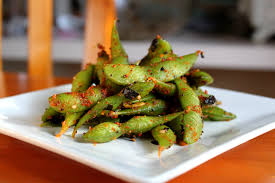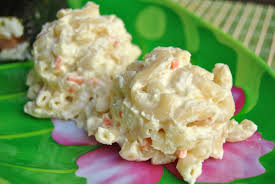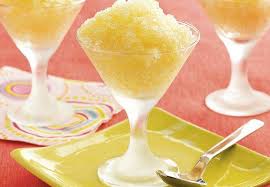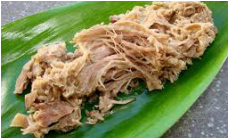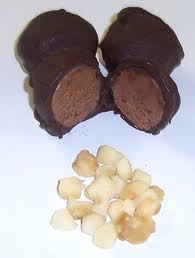
Hawaii is a paradise for more than one reason. The scenery is glorious, the weather is perfect all year round, the people are kind and welcoming, and the entire island chain is a food lover’s heaven. Our Hawaiian afternoon tea makes use of the lovely local ingredients that are plentiful on the islands. There are also some quirky aspects of Hawaiian cuisine, like the passion for Spam that pervades the culture. Hawaii is no place for food snobs. Let’s start our Hawaiian vacation with open hearts, open minds and the spirit of Aloha.
Haiku
Near the white ginger
Two dogs at twilight gnaw on
A fresh coconut.
Menu
Beverages:
Iced Hibiscus Tea
Hot Ginger Tea
Iced Kona Coffee
Almost Shave Ice: Pineapple and Coconut Granita Cups
Savories:
Spam Musubi (Seaweed Wrapped Rice Rectangles with Spam Filling)
Fried Poke (Spiced and Seared Ahi Tuna Cubes)
Hawaiian Banana Bread
Cream Cheese and Guava Jelly Sandwiches on Hawaiian Sweet Bread (Hawaiian Sweet Bread is actually Portuguese, brought to the islands by Portuguese immigrants who came to work as paniolos (Hawaiian cowboys) on local ranches. This bread is easy to find in any good grocery store on the mainland.)
Pulled Kalua Pig Sandwiches on Taro Rolls
Sweets:
Fresh Pineapple Chunks
Haupia (Coconut Gelatin Pudding Served in Cubes)
Kona Coffee Shortbread Cookies
Dark Chocolate and Macadamia Nut Truffles
Beverages:
Iced Hibiscus Tea
Hot Ginger Tea
Iced Kona Coffee
Almost Shave Ice: Pineapple and Coconut Granita Cups
Savories:
Spam Musubi (Seaweed Wrapped Rice Rectangles with Spam Filling)
Fried Poke (Spiced and Seared Ahi Tuna Cubes)
Hawaiian Banana Bread
Cream Cheese and Guava Jelly Sandwiches on Hawaiian Sweet Bread (Hawaiian Sweet Bread is actually Portuguese, brought to the islands by Portuguese immigrants who came to work as paniolos (Hawaiian cowboys) on local ranches. This bread is easy to find in any good grocery store on the mainland.)
Pulled Kalua Pig Sandwiches on Taro Rolls
Sweets:
Fresh Pineapple Chunks
Haupia (Coconut Gelatin Pudding Served in Cubes)
Kona Coffee Shortbread Cookies
Dark Chocolate and Macadamia Nut Truffles
Hawaiian Afternoon Tea—an afterthought
While this menu will create a lovely Afternoon Tea, which you can share with friends as you fantasize about actually being in Hawaii, you could also expand the menu for a special buffet meal for six to eight guests. This menu would make a beautiful Easter Buffet, Graduation Gathering, or Birthday Brunch. Here we offer a few suggestions for additions to the Hawaiian Tea menu to create a meal for a larger group. All of the supplementary foods we recommend are widely eaten in Hawaii and continue the spirit of Hawaiian cooking:
Boiled eggs or deviled eggs (brightly colored Easter Eggs for an Easter brunch)
Sweet potatoes baked in coconut milk
Spiced edamame (cooked soy beans in their pods)
Cole slaw
Macaroni salad (surprisingly popular in Hawaii!)
Ellen’s Coconut Cake from our Southern American Afternoon Tea Menu
While this menu will create a lovely Afternoon Tea, which you can share with friends as you fantasize about actually being in Hawaii, you could also expand the menu for a special buffet meal for six to eight guests. This menu would make a beautiful Easter Buffet, Graduation Gathering, or Birthday Brunch. Here we offer a few suggestions for additions to the Hawaiian Tea menu to create a meal for a larger group. All of the supplementary foods we recommend are widely eaten in Hawaii and continue the spirit of Hawaiian cooking:
Boiled eggs or deviled eggs (brightly colored Easter Eggs for an Easter brunch)
Sweet potatoes baked in coconut milk
Spiced edamame (cooked soy beans in their pods)
Cole slaw
Macaroni salad (surprisingly popular in Hawaii!)
Ellen’s Coconut Cake from our Southern American Afternoon Tea Menu
|
Recipes Included:
Almost Shave Ice: Pineapple and Coconut Granita Cups Anyone who has been to Hawaii knows that Shave Ice (without a “d” on the end of shave) is the most popular refreshing snack in the islands. And why not? It keeps everyone hydrated and makes use of the lovely fruits, such as guava, passion fruit (lilikoi,) mango, pineapple, and coconut that grow abundantly in the tropical climate. Shave Ice is really nothing but shaved ice, with a snow-like texture if possible, with fruit syrup poured over it, although real Shave Ice gourmets like to add extra toppings like ice cream, condensed milk, fresh fruit, azuki beans (Japanese style sweetened red beans) and mochi balls. While Shave Ice stands are everywhere in Hawaii, it is difficult to make this treat at home if you do not own an ice shaving device. For our readers who may not own an Ice Shaver, we offer a recipe for Pineapple and Coconut Granita, which you can make at home in your freezer. You might want to designate one friend to be the first to arrive at your Hawaiian Afternoon Tea and greet each guest with a small glass of Pineapple and Coconut Granita as they arrive. Granita is made of flavored ice crystals, and like Shave Ice, it melts very quickly, and cannot be served conveniently from a tea table. However, given to each guest, one by one, as they arrive, a glass of Granita can be like a lei, welcoming each person to the gathering. It will also serve as a foreshadowing of things to come, as the sweets for our Afternoon Tea include pineapple chunks and coconut gelatin. Spam Musubi Musubi is Japanese snack food. It is a hand-shaped rectangle of plain rice topped with cooked egg or meat attached with a strip of seaweed like a belt around the middle of the Musubi. This wildly popular sandwich substitute is sold at quick stop grocery stores and golf course snack bars all over the Hawaiian Islands. The Hawaiian version of this old Japanese favorite, with a slice of Spam on top, is the most popular of all. Even if you have never eaten Spam Musubi, you can become an honorary Hawaiian by making this simple snack at home. When you get started on this recipe, do not discard the Spam can, as you will be using it as a mold to shape the Musubi, which will be the same shape as a slice of Spam. Hawaiians who make Musubi all the time use little plastic molds for shaping the Musubi, but we will have to improvise. Fried Poke Poke (pronounced Poe-Keh,) shows up at every Hawaiian party from First Birthday Luaus to festive wakes. Poke is cubed, marinated raw fish, often ahi tuna or octopus, seasoned with onions and seaweed. Hawaiian grocery stores, fish markets and delicatessens offer fresh Poke every day, and much of the store-bought Poke is very fine quality. If you can find good Poke in your neighborhood, do not hesitate to bring it home for your Hawaiian Afternoon Tea and serve it on the day it was purchased. However, we suspect that some of our readers may not be too keen on the idea of eating raw fish, so we suggest pan searing the Poke just before serving time. And for our friends who do not have a Hawaiian fish market in the neighborhood, we offer this easy do-it-yourself Poke recipe. Traditional Poke contains Hawaiian kikui nuts and ogo seaweed, but these ingredients may be difficult to find. You can use chopped macadamia nuts as a substitute for the kikui nuts, but try to find the ogo if you can. If you can’t, a Poke spice mix, including dried ogo, is available from Noh Foods of Hawaii ([email protected].) You will need to rehydrate the ogo for a couple of minutes and follow the directions on the package. You can add the onions and the other ingredients on your own. Kalua Pig Pork is the most popular meat in Hawaii. Even today, many Hawaiians hunt feral pigs that run wild throughout the islands and roast the pigs whole in an underground fire pit known as an imu. We don’t expect you to kill your own pig. In fact, our Kalua Pig recipe can be made with minimal effort by cooking the pork overnight in a slow cooker. The next day, you just shred the meat to make pulled pork and create your own little sliders by serving the meat on store bought or freshly baked taro rolls. Taro Rolls Taro is the nutritional root from which the purple paste known as poi is made. Tourists are invariably served poi at luaus, and many do not appreciate this healthy food. Mashed taro may be sticky and bland, but it is the taro root that sustained the Polynesian seafarers who came to the Hawaiian Islands hundreds of years ago in their outrigger canoes looking for new opportunities to fish and farm for their families. We must learn to respect the humble taro root. Taro has fed generations of Polynesians, and it can be used in all kinds of cooking, including baking. Taro Rolls, made with poi, are soft, fragrant and delicious. If you can find fresh Taro Rolls in a bakery, buy them. We also offer this recipe by Betty Shimabukuro, which appeared in the Honolulu Star Advertiser, so you can make your own. However, the first ingredient is poi, which you will have to find in a Hawaiian or Asian market. Ms. Shimabukuro recommends adding purple food coloring to create the appearance of the purple taro root. Normally we do not like to use artificial food coloring, but Betty says, “if you don’t use it, your rolls just won’t look right.” Hawaiian Banana Bread Hawaiian Banana Bread is often sold from trucks or roadside stands by women who have whipped up a batch using the bananas growing in their back yards. Hawaiian Banana Bread is not fancied up with the addition of nuts, chocolate chips, raisins or coconut. This recipe, adapted from Julia’s Banana Bread, comes from the island of Maui where Julia sells this very basic and exquisite bread from a roadside stand. The secret for perfect banana bread is to make sure that the bananas are very, very ripe, black and drippy preferred. Haupia (Coconut Gelatin Pudding) Haupia is a refreshing coconut dessert that shows up on every Hawaiian buffet table and at every Luau. Basically, Haupia is a thick, gelatin-like coconut pudding. At traditional Hawaiian meals and parties, chilled Haupia is cut into 1-inch squares and served on the broad leaves of the Ti plant, which function as bright green platters. Haupia can also be used as a pie filling. Often additional coconut and chocolate are added to hot Haupia pudding to make Chocolate Haupia Pie, a very popular dessert that can be purchased at local grocery stores or prepared at home. For our traditional Hawaiian Afternoon Tea, we will serve the Haupia in cubes. And to make the host’s life even easier, we will take the unusual step of recommending a packaged Haupia mix, which can be stirred up in the time it takes to boil water. Barbara Oki of the Oki Diner in Kauai developed this pudding mix. Rose has made Haupia using this mix, and her Hawaiian friends asked her if she made the pudding from scratch. If you cannot find the bright blue package of Hawaiian Haupia Luau Pudding Squares in your local grocery store, you can order it from: Kauai Tropical Syrup, Inc. 3215 Uluhui Street, Lihue, Hawaii, 96766 Telephone: 1-808-652-6618 Email: [email protected] Website: www.kauaitropicalsyrup.com Kona Coffee Shortbread Cookies Shortbread Cookies, perhaps introduced by American missionaries or British sailors, are very popular in Hawaii. Both the Honolulu Cookie Company and Big Island Candies make very good Shortbread Cookies, and the former will ship cookies to the mainland. However, you can make your own Coffee Shortbread Cookies from this easy recipe. Coffee is an important agricultural crop in Hawaii, and we hope you will use Hawaiian Kona Coffee for this recipe, though we must admit that instant espresso powder works just as well. Dark Chocolate and Macadamia Nut Truffles Chocolate Truffles are one of life’s little pleasures. If most people knew how easy they are to make, they would never buy a commercial candy bar again. Chocolate Truffles are nothing more than hot butter and cream poured over chopped chocolate, chilled and formed into little tasty balls of goodness. All sorts of flavorings can be added, from brandy to orange peel to finely diced dried fruits such as cherries or cranberries, and nuts are a perfect addition to Chocolate Truffles. For our Hawaiian Afternoon Tea, macadamia nuts, which are grown throughout the islands, are the natural choice to create the perfect little tropical treat. |




